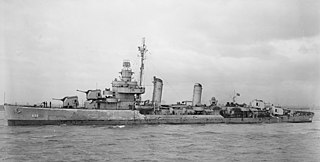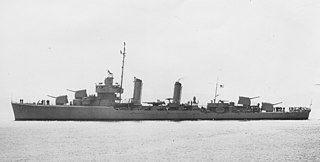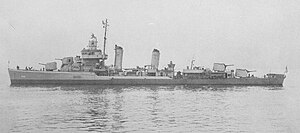
USS Hogan (DD-178/DMS-6) was a Wickes-class destroyer in the United States Navy during World War II.

USS Howard (DD–179), (DMS-7) was a Wickes-class destroyer in the United States Navy during World War II. She was named for Charles W. Howard, who was killed in the American Civil War aboard USS New Ironsides.
USS Dallas (DD-199) was a Clemson-class destroyer in the United States Navy during World War II. She was the second ship named for Captain Alexander J. Dallas, and was later renamed Alexander Dallas.

USS Rodman (DD-456/DMS-21), a Gleaves-class destroyer, is the first ship of the United States Navy to be named for Admiral Hugh Rodman.

USS Emmons (DD-457/DMS-22) was a Gleaves-class destroyer of the United States Navy, named for Rear Admiral George F. Emmons (1811–1884).

USS Macomb (DD-458/DMS-23) was a Gleaves-class destroyer of the United States Navy, named for Commodore William H. Macomb (1819–1872) and Rear Admiral David B. Macomb (1827–1911).

USS Mervine (DD-489/DMS-31), a Gleaves-class destroyer, was the second ship of the United States Navy to be named for Rear Admiral William Mervine, who served during the War of 1812, the Mexican–American War and the American Civil War. Mervine was laid down on 3 November 1941 by the Federal Shipbuilding & Dry Dock Company of Kearny, New Jersey and launched on 3 May 1942, sponsored by Miss Mildred Mervine great-granddaughter of the admiral. The ship was commissioned on 17 June 1942.

USS Quick (DD-490/DMS-32), a Gleaves-class destroyer, was a United States Navy warship named for Sergeant Major John H. Quick (1870–1922), who received the Medal of Honor "for gallantry in action" at Guantanamo Bay, Cuba, 14 June 1898, during the Spanish–American War.

USS Knight (DD-633), a Gleaves-class destroyer, is the only ship of the United States Navy to be named for Admiral Austin M. Knight.

USS Doran (DD-634), a Gleaves-class destroyer, was the second ship of the United States Navy to be named for Medal of Honor recipient John James Doran.

USS Trever (DD-339/DMS-16/AG-110) was a Clemson-class destroyer of the United States Navy in commission from 1922 to 1923 and from 1930 to 1945. Converted to a destroyer minesweeper in 1940, she served in the Pacific throughout World War II, including during the Japanese attack on Pearl Harbor, the Guadalcanal campaign, and the New Georgia campaign.

USS Cowie (DD-632), a Gleaves-class destroyer, is the only ship of the United States Navy to be named for Rear Admiral Thomas Jefferson Cowie.

USS Jeffers (DD-621/DMS-27), a Gleaves-class destroyer, was the only ship of the United States Navy to be named for Commodore William N. Jeffers.

USS Davison (DD-618/DMS-37), a Gleaves-class destroyer, was named for Lieutenant Commander Gregory C. Davison (1871–1935). Davison specialized in torpedo boat operations.

USS Carmick (DD-493/DMS-33), a Gleaves-class destroyer, was the only ship of the United States Navy to be named for Major Daniel Carmick (1772–1816), an officer in the United States Marine Corps who served during the Quasi-War with France and during the War of 1812.

USS Forrest (DD-461/DMS-24), was a Gleaves-class destroyer of the United States Navy.

USS Fitch (DD-462/DMS-25), was a Gleaves-class destroyer of the United States Navy.

The third USS Davis (DD-395) was a Somers-class destroyer in the United States Navy. She was named for Charles Henry Davis.

USS Speed (AM-116) was an Auk-class minesweeper acquired by the United States Navy for the dangerous task of removing mines from minefields laid in the water to prevent ships from passing.

USS Gherardi (DD-637/DMS-30), a Gleaves-class destroyer, is the only ship of the United States Navy to be named for Rear Admiral Bancroft Gherardi.



















